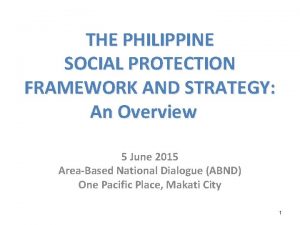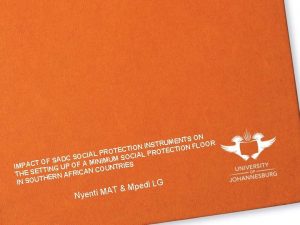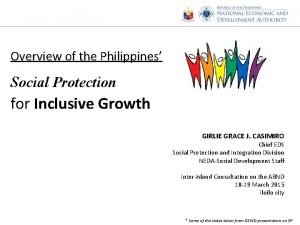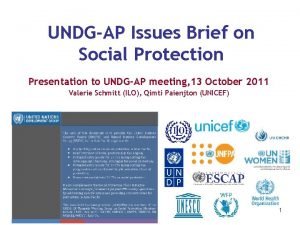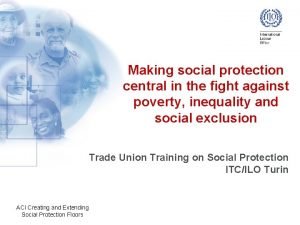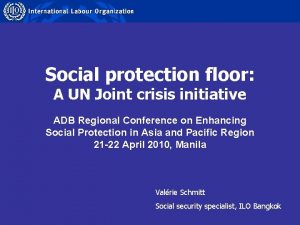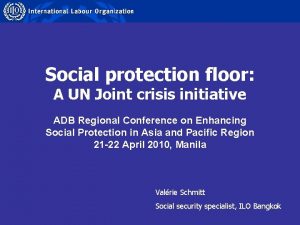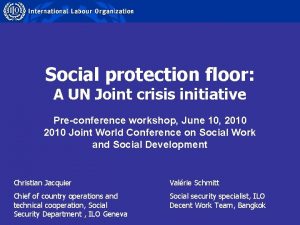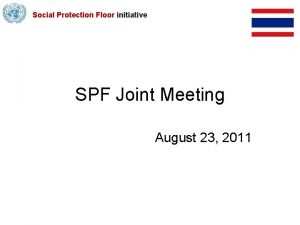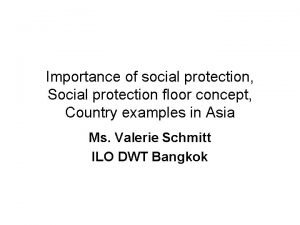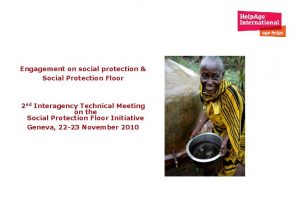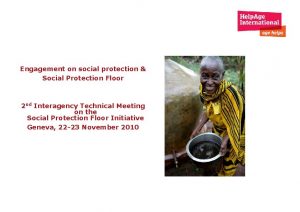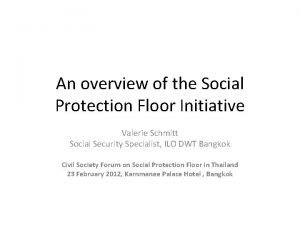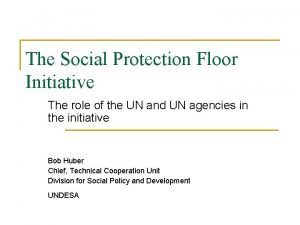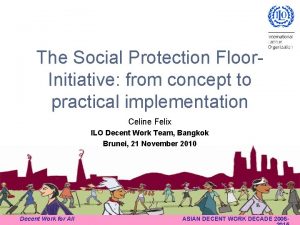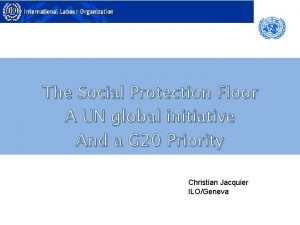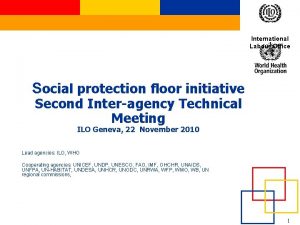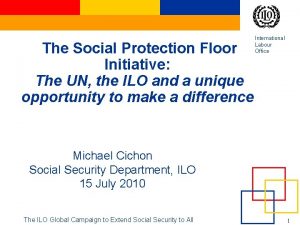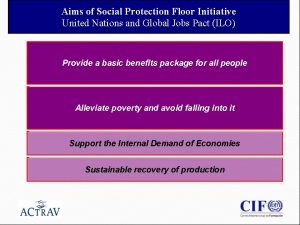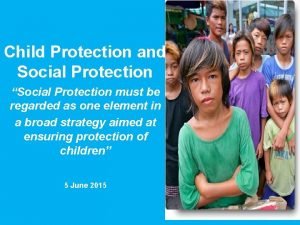Social protection floor A UN Joint crisis initiative

























- Slides: 25

Social protection floor: A UN Joint crisis initiative Pre-conference workshop, June 10, 2010 Joint World Conference on Social Work and Social Development Christian Jacquier Valérie Schmitt Chief of country operations and technical cooperation, Social Security Department , ILO Geneva Social security specialist, ILO Decent Work Team, Bangkok

Structure of the presentation 0. Definitions: social protection, social security … I. The issue: low level of social protection coverage, although many arguments to justify the extension II. The UN CEB Social protection floor initiative as a response to the crisis III. The SPF is affordable and feasible IV. What can be done to support the Social Protection Floor initiative? a) Global level & regional level b) Country level

Definitions: social protection, social security … • Social security is a coherent set of public measures provided by society to its members – To provide people with health care – To compensate for the absence or substantial reduction of income from work resulting from : • Sickness, Maternity, Work Injury, Unemployment (Short term benefits) • Death of the breadwinner, Invalidity, Old age (Long term pensions) – To provide benefits for families with children and facilitate access to education (scholarships, CCTs) • Social protection includes also private or nonstatutory schemes with similar objectives

I- The issue: low level of coverage … SOURCE: (ILO, 2010)World Social Security Report Providing coverage in the time of crisis and beyond Preliminary version, 15 March 2010 Health protection: Proportion of the population covered by law, latest available year (percentages) Lack of coverage

I- The issue: low level of coverage … SOURCE: (ILO, 2010)World Social Security Report Providing coverage in the time of crisis and beyond Preliminary version, 15 March 2010 Old-age pension beneficiaries (C and NC) as a percentage of the population above retirement age, latest available year Lack of coverage

SOURCE: (ILO, 2010)World Social Security Report Providing coverage in the time of crisis and beyond Preliminary version, 15 March 2010 I- The issue: low level of coverage … Existence of unemployment protection schemes by type of scheme, 2008– 09 Lack of coverage

I- … Although many arguments to justify the extension • Social security is a basic human right : – Universal Declaration of Human Rights (1948), Article 22: Everyone, as a member of society, has the right to social security – International Covenant on Economic, Social and Cultural Rights (1966), Article 9: « recognize the right of everyone to social security, including social insurance » • One area of social security (access to health) is adressed by a specific right: the right to health • Consequences : – States and international community have the obligation to take appropriate measures to guarantee this right (legal, administrative, budgetary …) – Each individual is entitled to a minimum level of social protection, without exception or discrimination • ILO Conventions and recommandations provide useful guidance for the design of SS legislations – ILO C 102, 1952: Flagship convention of social security

I- … Although many arguments to justify the extension • Social security has a redistribution function and therefore – Contributes to protect people from economic and social shocks – Contributes to reduce poverty and inequalities • Income transfers through social security have a short term and a longer term effect on income inequality & moving out of poverty – Contributes to boost consumption of households & to the development of the domestic market, and a more balanced economy • Boost economic growth by raising domestic demand / internal markets • Enhance human capital and productive employment - a better educated, healthy and well nourished workforce

I- … Although many arguments to justify the extension • In times of crisis, social security systems are social and economic stabilizers – They mitigate the economic and financial impact of Unemployment and Under-Employment on workers and their families social stability • Most of the fiscal stimulus packages adopted by the governments included social protection components – They support aggregate domestic demand facilitate recovery • Lessons learned from past crises: countries that had effective and efficient social security systems in place were much better equipped than those who had not put such systems into place.

I- … Although many arguments to justify the extension • Social protection floor impact on poverty in Brazil: % of poor with/without a social pension in 2007 Com transferências previdenciárias Sem transferências previdenciárias +22, 2 milhões de pessoas pobres Fonte: PNAD/IBGE – 2007. Elaboração: SPSMPS. * Linha de Pobreza = ½ salário mínimo. Obs: Foram considerados apenas os habitantes de domicílios onde todos os moradores declararam a integralidade de seus rendimentos.

II- The UN CEB Social protection floor initiative • On April 2009, the UN Chief Executives Board (CEB) have agreed on nine joint initiatives to confront the crisis, accelerate recovery and pave the way for a fairer and more sustainable globalization: 1. 2. 3. 4. 5. 6. 7. 8. 9. Additional financing for the most vulnerable Food Security Trade A Green Economy Initiative A Global Jobs Pact A Social Protection Floor Humanitarian, Security and Social Stability Technology and Innovation Monitoring and Analysis

II- The UN CEB Social protection floor initiative • Who participates in the SPF initiative? – National stakeholders including governments (Ministries of Labour, Health, Finance, Agriculture …); social partners; national NGOs – 17 Agencies: ILO and WHO (co-leaders), FAO, OHCHR, UN regional commissions, UNAIDS, UNDP, UNDESA, UNESCO, UNICEF, UNFPA, UNHABITAT, UNHCR, UNODC, UNRWA, WFP, WMO – The World Bank and IMF – Regional development banks, bilateral donors, global funds – International NGOs (Helpage, ISSA, Care …)

II- The UN CEB Social protection floor initiative • The SPF Initiative aims at ensuring access to essential services and social transfers for the poor and vulnerable. It focuses on 2 critical components: Supply of essential services for all the population: -housing, -education, -health care supply, -water and sanitation, -food, etc. Supply Financing access to essential health care (HEFs, CBHI, Subsidized health insurance …) Minimum income support : -to children (family/child benefits), -the working poor (cash transfers and PWPs) -and the elderly (minimum pensions) … to ensure access to basic social services. Demand • The two dimensions (supply and demand) are complementary and articulated

II- The UN CEB Social protection floor initiative Social services & transfers For… Types of programs Health: Health care supply + Financial / Physical access All population Subsidized health insurance, HEFs … Education: Supply of schools + Financial / Physical access Children Scholarships, School feeding programs Water, Food, Sanitation, Housing: Transfers in kind: food, water … All the poor Food distribution, water supply Minimum income: Transfers in cash Families with children Family/Child allowances Working poor, underemployed PWPs, employment guaranteed schemes Elderly, disabled. . Minimum pensions

II- The UN CEB Social protection floor initiative • The SPF is not only an anticrisis measure but an essential part of each country’s national social security strategy which may have 2 dimensions: 1. An horizontal dimension : Extension of the SPF (minimum income security and access to health care) to the whole population (“minimum core content”). 2. A vertical dimension aims to provide higher levels of income security and access to higher quality health care. 2. 1. Of course in many countries it is less schematic…

II- The UN CEB Social protection floor initiative • Illustration of horizontal/vertical extension in Cambodia: 2. Vertical coverage: providing higher levels of social security benefits through contributory schemes Civil servants SOCIAL SECURITY (NSSF and NSSF-C) Formal sector Workers Informal Economy Near poor Very poor SOCIAL PROTECTION STRATEGY FOR THE POOR AND VULNERABLE • Food security (school feeding programs, distribution of food) • Child benefits, • Public CCTs (to enhance works school attendance and access to health care) SOCIAL HEALTH PROTECTION STRATEGY: SHI, CBHIs, Equity funds • Health Equity Funds 1. Horizontal coverage: providing a social protection floor for all

III- The SPF is affordable and feasible Evidence emerges that a minimum package of social security benefits is affordable in even the poorest countries (recent work by the ILO on the cost of a minimum package in sub-Saharan Africa, Asia and Latin America). A SPF is possible from a financial and macro-economic point of view in every country (3 to 5 % of GDP). SP is rather a cost -effective investment in human capital.

III- The SPF is affordable and feasible • Elements of the SPF already exist in many developing countries (85) Comprehensive SPF: Brazil, Mexico, Chile, Uruguay Social pensions: Brazil, South Africa, Bolivia (pension dignidad), Chile (pension basica solidaria), Thailand (500 Bath scheme), China (rural old age pension)… CCTs: Brazil (Bolsa Familia), Mexico (Oportunidades) HEALTH: China (urban & rural), India (RSBY), Thailand (UCS), Mexico (Seguro popular), Colombia (regimen subsidiado), Uruguay, Chile (plan AUGE), Burkina Faso, Rwanda … Employment guarantee schemes: India (NREGA), Uruguay (Política de empleo promovido), Argentina (Plan jefes y jefas de familias)

IV- What can we do to support the SPF? • At Global level: A SPF Advisory Network – Composed of focal points of the UN agencies, WB, IMF… – It aims at providing support to the country teams and at monitoring progress at global and regional levels, through: • • • GESS Platform Knowledge management TURIN Capacity building for national planners ILO EU project Joint advocacy and Fund raising Developing a common implementation framework Monitoring, evaluating and reporting A Manual joint UN during a a global action. and strategic framework for country operations was drafted workshop in Turin; it proposes and a national framework for

IV- What can we do to support the SPF? http: //www. socialsecurityextension. org

IV- What can we do to support the SPF? • At country level (examples in Asia): China, – Establish / work within SPF teams or taskforces Thailand – Advocacy, awareness raising – Common understanding (with UN agencies, government …) Cambodia – Documentation of experiences SPF Success Stories – Rapid assessment, shared diagnosis (workshop) Thailand, Vietnam… – Support to the development of national SPF strategy Cambodia (SP strategy for the poor and the vulnerable) – Support to the implementation of these strategies • • Social budgeting, costing exercises Cambodia (CARD) Legal work Design & implementation of SPF schemes Lao PDR (health) Monitoring and evaluation of the SPF expansion Cambodia (CARD)

IV- What can we do to support the SPF? • The role of NGOs and civil society: Advocacy & awareness raising among • Policy makers (arguments on balanced and equitable growth, being prepared for the future crisis, etc) • Employers (implementing the floor can be part of a differentiation strategy (fairness / equity / redistribution); it is also a matter of CSR towards own staff and subcontractors, as well as surrounding population; it contributes to increase productivity …) • Informal economy workers and rural populations • General public (that have also a responsibility as consumers) – Concrete activities: • Find “ambassadors”, document and disseminate good practices, produce brochures targeting each public, media campaigns …

IV- What can we do to support the SPF? • The role of NGOs and civil society: Design of SP strategies and SPFloor – NGOs, associations know better than policy makers the specific needs of the target groups • Cambodia, National Social Protection Strategy for the poor and vulnerable, associations dealing with vulnerable groups were involved; • India, NREGA, local communities involved in the choice of public infrastructures to be built under the scheme (schools, roads, irrigation…).

IV- What can we do to support the SPF? • The role of NGOs and civil society: Implementation of the SPFloor – The missing link between central level and populations … • Targeting (ex: community targeting) • Channeling funds within cash transfer programmes (ex: local microfinance institutions) • Registration, claims management, local relations with HC providers (ex: role of mutual health organizations within nation-wide schemes: Colombia, Burkina Faso, Philippines) – The floor supplements their own activities and can therefore reinforce their impact • RSBY in India provides Inpatient insurance; Micro-insurance schemes can concentrate on prevention, education and outpatient care

Thank you! THANK YOU! Questions?
 Myasthenic crisis vs cholinergic crisis
Myasthenic crisis vs cholinergic crisis Functional requirements of timber ground floor
Functional requirements of timber ground floor A grade lamb
A grade lamb Hyaline cartilage in vertebrae
Hyaline cartilage in vertebrae Non permanent joint คือ
Non permanent joint คือ Memorandum joint venture method
Memorandum joint venture method Lamb grading chart
Lamb grading chart Fibrous joints
Fibrous joints Dominos pizza pr
Dominos pizza pr Social thinking and social influence
Social thinking and social influence Social thinking social influence social relations
Social thinking social influence social relations Social protection operational framework philippines
Social protection operational framework philippines Social protection instruments
Social protection instruments Social protection operational framework philippines
Social protection operational framework philippines Social protection
Social protection Handling information in health and social care
Handling information in health and social care Ilo social protection
Ilo social protection Unit 9 developmental psychology
Unit 9 developmental psychology Cardiogenic shock
Cardiogenic shock The cyberspace learning initiative
The cyberspace learning initiative Secure digital music initiative
Secure digital music initiative Pharmaceutical supply chain initiative psci
Pharmaceutical supply chain initiative psci Northern waterfront economic development initiative
Northern waterfront economic development initiative Loni pop
Loni pop South african furniture initiative
South african furniture initiative Inidicia
Inidicia











